Development of MW & THz Clinotrons
Submillimeter wave range is of considerable interest for an increasing number of applications in the technologies and many scientific researches including:
- high data rate communications,
- remote high resolution imaging,
- chemical spectroscopy,
- materials research,
- deep space research and communications,
- biomedical diagnostics,
- radar and remote sensing system,
- diagnostics of plasma,
- concealed weapon or threat detection and etc.
Currently, the backward wave oscillators (BWO) are primarily used in the submillimeter spectroscopy. However, the BWO output power drops to a few milliwatts for wavelengths shorter than 1 mm. It is caused by exponential decay of evanescent wave from slow wave structure (SWS) and hence reducing of effective electron beam (EB) thickness at THz range.
In order to increase the efficiency of the interaction of EB with the slow wave it is required to increase the EB current density. For frequencies above 200 GHz, the current density should be 50 A/cm2 or even more. On the other hand, the use of intense electron beams requires a focusing system that provides EB pulsation value smaller than the thickness of the layer in which the slow wave field is concentrated.
In this connection the promising oscillator in submillimeter range is BWO-clinotron whose power is higher than in conventional BWO more than an order under the same parameters of electronic tuning of oscillation frequency in a wide range. In clinotron EB is inclined to SWS. Because of EB inclination all electrons come close to SWS and interact with strong electric field that increases output power. Also clinotron cavity has no absorbers at the SWS ends and strong reflections take place at beam entrance and exit providing clinotron resonant properties. Although clinotron is resonant device, its frequency tunability is about 15%.
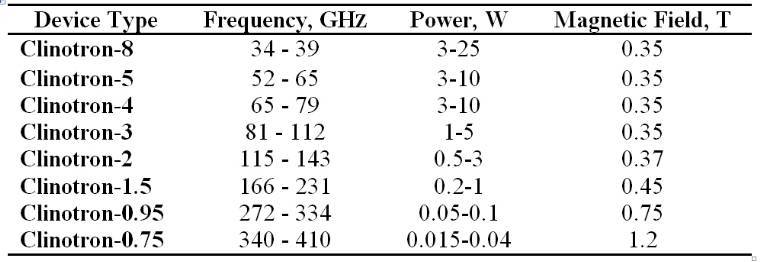
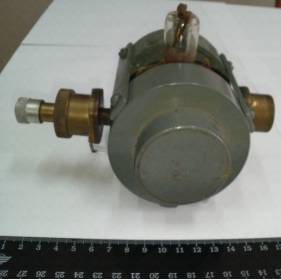
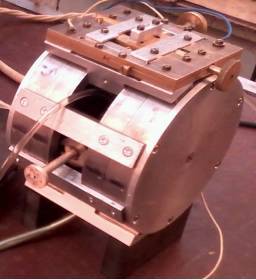
Millimeter Waveband Clinotron Tube Design
THz Clinotron Tube Design
400 GHz CW Clinotron Development
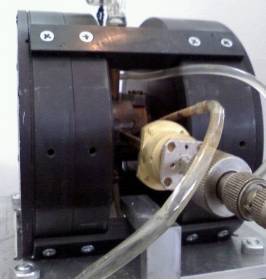
The clinotron oscillator was designed for the 0.74 - 0.89 mm wavelength range. For calculation of SWS dispersion characteristic we used the mode matching technique.
In the developed 400 GHz CW clinotron oscillator the sheet EB with cross-section 0.15 mm x 2.5 mm was formed by high-perveance diode electron gun without compression. The barium-oxide impregnated cathode used in the gun enables operation with more than 50 A/cm2 EB current density.
The range of gun filament current and voltage is 1.35 – 1.55 A and 6 – 7.5 V, respectively. The gun is designed to operate with an accelerating voltage of up to 5.5 kV.
To provide sufficient focusing of the EB the experimental clinotron oscillator was placed in a multiple-section Magnetic Focusing System (MFS) with the magnitude of the magnetic field equal 1.2 T in magnet bore of 34 mm. Applied magnetic material in MFS is Nd-Fe-B.

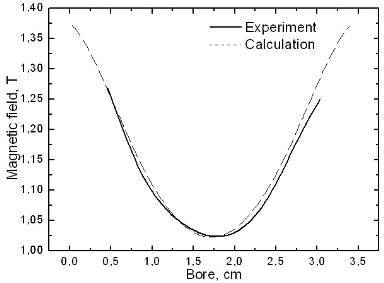
The distribution of the longitudinal component of the magnetic field in the magnet bore.
Excitation of 400 GHz clinotron prototype took place at 2.6 - 4.3 kV accelerating voltage range and at 60 - 200 mA EB current range, that corresponded to the following parameters of the filament current and voltage: 1.35 - 1.5 A x 5 - 6.8 V.
Starting current was only 61 mA at filament mode 1.35 A x 5.7 V. In experiment we measured frequency and power characteristics of the device. To compare ‘cold’ theoretical frequencies with ‘hot’ experimental ones follow figure shows both dispersion and experimental points.

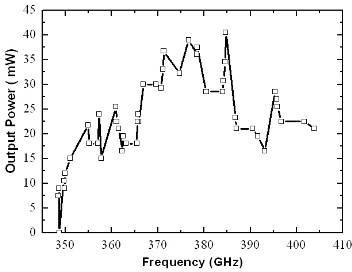
Calculated dispersion and experimentally measured results.
The study of clinotron frequency characteristics were carried out by the interferometric method. We used a quasi-optical wavemeter based on Michelson interferometer. Power measurement was carried out by bolometric method by using a calibrated power meter. The developed clinotron was excited in a wide frequency range with an average power of 20 mW.
The frequency tuning was more than 20%. Maximum output power was within the frequency range 370 - 387 GHz and was 30 - 43 mW.







